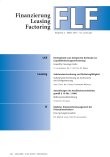Sie befinden sich hier: Home › FLF › Themenschwerpunkte › Aufsätze › The EUF shares its study of six European factoring markets
Aufsätze
04.03.2015
The EUF shares its study of six European factoring markets
Analysis confirms the Industry's economic value

John Brehcist

Dieser Artikel ist Teil unseres Online-Abo Angebots.